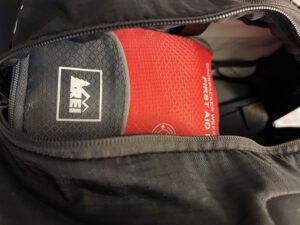Carrying a well-stocked first aid kit when you travel is essential to protect yourself from the inevitable accidents and occasional illnesses that can kill a great trip.

Travel first aid kits provide a safety net for less severe medical ailments and issues until you can consult a physician.
Your travel first aid kit, first and foremost, is a safety net for less serious ailments and medical issues that you can manage yourself until you can obtain professional medical assistance.
I’ve gathered first aid kit recommendations from top medical institutions and arranged them into five categories. I’ve explained some of the items that should be in your first aid kit.
Many commercial first aid kits are available for travelers, but while they are great starting points, they will need numerous additions.

I suggest you check the various offerings, looking at content and price. Some may be great starting points for you. I call them that because it’s unlikely that you will find one that contains everything you need for the location to which you’re traveling or that has over-the-counter medications you wish to bring with you. My kit started as one I bought, and I reconfigured it for my use and needs.
Here are my recommendations for critical components for travelers’ first aid kits.
Here are my first aid kit categories containing a complete list of components that should be in your travel first aid kit.
1. Cuts, scrapes, bruises, sprains, etc.:
• Tweezers – These are essential for splinters and ticks. Don’t forget to disinfect the tweezers before and after each use.
• Gauze Pads – I’ve found that gauze pads are often more helpful than band aids because of their versatility. I always put band-aids in my first aid kit and I never forget to have gauze pads, as many cuts and scrapes are too significant for band aids. You’ll often need surgical tape to hold the pads in place.
• Surgical Tape
• Surgical Gloves – These help prevent infection when treating wounds. I recommend Nitrile gloves because they contain no natural latex, a substance that causes allergy issues for many.
• Bandage Scissors (travel size) – These are useful to cut gauze pads, moleskin, and other items while traveling.
• Antiseptic wipes – These can be used to clean and disinfect materials used to treat medical victims.
• Antibiotic ointment
• Roller Gauze
• Band aids
• Triangular bandages – A triangular bandage can be used as a sling and other ways to help travelers.
• Barrier devices for CPR – CPR barriers are devices to protect you from exposure to infection when in close contact with victims who you are trying to save.
• Hydrogen peroxide – This is used to clean and disinfect wounds.
• Eyewash solution – If you can fit eyewash solution in your kit, put it in. Otherwise, ensure you have plenty of water to use to clean your eyes when you’re out and about.
• Bandage closures such as butterfly bandages
• Safety pins – These can come in handy for many situations when applying first aid.
• Cold packs and a compression ice pack wrap – For sprains, savvy travelers use the RICE method of Rest, Ice, Compression, and Elevation. Ice cubes won’t be available in the middle of nowhere, but cold packs can fill the void when out and about. To increase its effectiveness, you’ll need a compression ice pack wrap to hold the cold pack on the sprain.
• Moleskin patches – Use them for blisters.
• Nonwoven travel washcloth and towel
• Aluminum finger splint
• Duct tape – Duct tape is the most flexible and generally helpful tape for many uses.
Your travel first aid kit should include medications not part of commercially available first aid kits.
2. On-the-go illnesses and medical problems:
• Thermometer
• Acetaminophen, ibuprofen, or aspirin to relieve headaches, pain, fever, and simple sprains or strains
• Antihistamines to relieve a severe unexpected allergic reaction and environment allergens.
• Calamine lotion for treating pain, itching, and discomfort from skin irritations due to poison ivy and other skin irritants.
• Antinausea medicine
• Insect bite swabs
• Motion sickness medicine (You may also want to include treatment for altitude sickness if traveling to high altitudes.)
NOTE: For severe motion sickness, a Scopolamine patch (prescription needed) might be the best choice if you’re expecting severe motion sickness. For example, I wore one the entire time my ship was in the Drake Passage, the roughest seas in the world. It worked great.
• Antacid medicine
• Anti-diarrhea medication – Talk to your doctor about obtaining a prescription anti-diarrhea medication, as they are typically more effective than the over-the-counter versions.
• Laxative
• Aloe vera gel – Use this product for sunburns.
• Cold and cough relief medication
• Rehydration tablets
Chronic illnesses often require a variety of medications. In case you are delayed returning home, take an extra two-week supply of all your drugs, just in case.
3. Chronic illnesses:
• You should pack any medicines you take regularly. Don’t just take enough of the medications for the duration of your trip. I assume that I might be delayed for as long as two weeks. Therefore, I take enough medication to last for two weeks past the planned end of my journey.
• For prescription medications, pack them in their original container with labels that identify the drug and dosing, plus determine that they are prescribed for you.
NOTE: If you have a serious chronic condition such as diabetes, allergies that can cause anaphylaxis, epilepsy, heart condition, etc., consider joining the Medical Alert Foundation and wearing a Medic Alert bracelet or necklace.
4. Preventatives:
• Insect Repellent – I recommend one with DEET.
• Sunscreen – The American Academy of Dermatology recommends that everyone use a sunscreen with an SPF of 30 or higher, that it’s broad-spectrum sunscreen (protects against UVA and UVB rays) and one that has water resistance so it won’t easily wash off.
• Water purification kit – I use a SteriPen and a water filter for more than a day when I’m out in the wild.
• Water to prevent dehydration
Some destinations have specific medical issues travelers need to plan for and include items in their first aid kit.
5. Destination medical issue additions for your first aid kit:
• Vaccinations for such illnesses as COVID-19, Small Pox, Hepatitis A and B, Measles, Yellow Fever, Typhoid, Influenza, etc.
• Appropriate Face Masks and alcohol-based hand sanitizer for COVID-19.
• Snake bite kit – Medical experts say that commercial snake bite kits likely do more harm than good. The best thing to do is get in touch with emergency assistance for treatment of a snake bite. Keeping a cellphone with you to get immediate medical help is essential for snake bite victims.
• Antimalarial medication

READ ALSO:
How does the cruise line bill of rights and refund policy affect you
Lodging properties hurt themselves with a discount hotel site that allows dishonest advertising
After many years working in corporate America as a chemical engineer, executive and eventually CFO of a multinational manufacturer, Ned founded a tech consulting company and later restarted NSL Photography, his photography business. Before entering the corporate world, Ned worked as a Public Health Engineer for the Philadelphia Department of Public Health. As a well known corporate, travel and wildlife photographer, Ned travels the world writing about travel and photography, as well as running photography workshops, seminars and photowalks. Visit Ned’s Photography Blog and Galleries.



